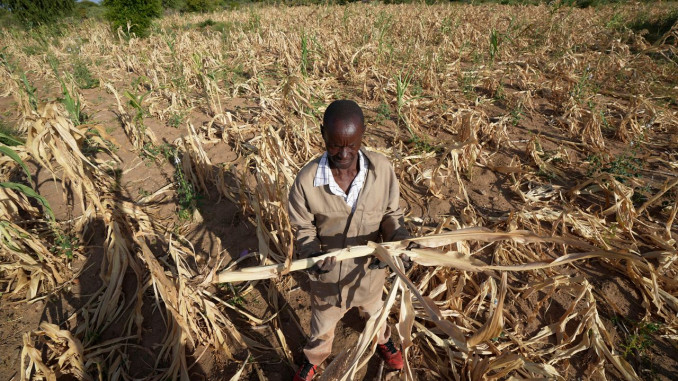Southern Africa is on the brink of a hunger crisis after an historic drought decimated crops during the peak October to March farming season – one year after the region was pummelled by tropical storms
Zambia, Malawi and Zimbabwe declared national disasters within weeks of each other after insufficient rains wiped out crops including the staple maize harvest.
The severe dry spell – exacerbated by the El Nino weather pattern that triggers higher global temperatures – has reached Botswana and Angola to the west, and Mozambique and Madagascar to the east.
The World Food Programme (WFP) said that some areas had suffered their driest February in 40 years.
As many as 50 million people are facing food insecurity.
Authorities in Zambia have ordered the army to support food production, with 84 of the country’s 116 districts stricken by a drought that has also wrought havoc on electricity supplies.
Zambia is highly reliant on hydroelectric power.
Harvest write-off
Almost three-quarters of Zambia has gone without any rain since January, said Chris Mzembé of the Lusaka branch of the NGO Care International.
In places where it has rained, the water came in violent storms that destroyed crops, Mzembé told RFI – adding that many maize farmers, especially the smallest, lost everything.
“They spent all their money on buying seeds and fertilisers and paying for labour and then their crops died,” he said. “Their entire investment is therefore gone.”
Like in Zimbabwe, maize production drives the country’s agricultural sector and is at the heart of the local diet.
It’s also used as livestock feed and in various industrial processes including the production of maize flour, maize starch, corn oil and ethanol.
Coupled with rising food prices and an unstable local currency, the plummeting maize yields have caused widespread panic.
“Both individuals and companies have started holding back (maize-based) goods because they anticipate they’ll be able to sell for more tomorrow,” Mzembé said.
“This could aggravate the crisis and further increase prices.”
This year’s harvest write-off means that millions of people in southern Africa won’t be able to feed themselves until well into 2025.
USAid’s Famine Early Warning System estimated that some 20 million people would require food relief in the first few months of this year.
While these are normally “lean months” as families wait for the new harvest, this year there will be little hope for replenishment.
Aid appeals
Malawi says it needs more than €200 million in immediate humanitarian assistance, having declared a state of emergency in 23 of its 28 districts.
Zimbabwean leader Emmerson Mnangagwa says the country needs €2 billion in aid. Families have been urged to conserve food as authorities work with charities and UN agencies to bring in supplies.
Nearly 20 percent of Zimbabwe’s population – 2.7 million people in rural areas – benefits from food aid already.
Meanwhile Zambia has also appealed for international help.
With the next crop growing season a year away, the British charity Oxfam has warned of acute food shortages and malnutrition for more than six million Zambians – or 30 percent of that country’s population.
But humanitarian agencies including WFP say resources are stretched as it is because of funding cuts by governments, despite growing demand for food aid in many parts of the world badly affected by climate shocks.
Scientists have warned that extreme weather will continue to become more frequent and more damaging, and that vulnerable communities will be worst hit.
